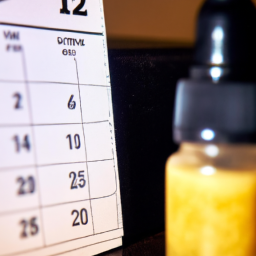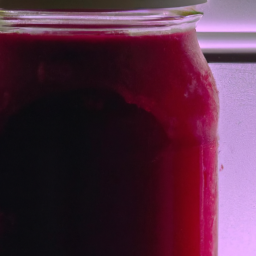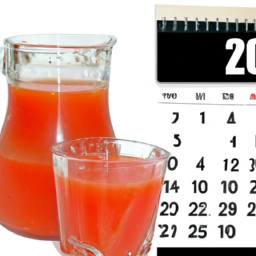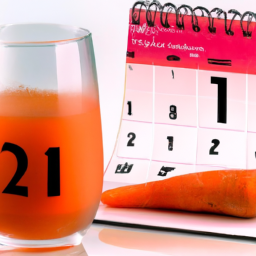Vaping has become a widespread hobby around the world in recent years. The different flavors, the impressive clouds, and the satisfying nicotine hit make it an addictive and enjoyable experience. However, as a vaping enthusiast, I recognize the importance of storing vape juice properly for optimal longevity. Improper storage can cause spoilage and impact your vaping experience negatively.
In this article, we’re going to explore the science behind the shelf life of vape juice. We’ll delve into the factors that affect how long vape juice lasts and provide tips on how to extend its shelf life. Whether you’re a beginner vaper or a seasoned pro, understanding the shelf life of vape juice is essential to ensure that you always have a great vaping experience.
So, buckle up and get ready to learn all about the shelf life of vape juice!
Key Takeaways
- Factors affecting shelf life of vape juice include quality of ingredients, storage conditions, and usage.
- Proper storage conditions, such as keeping the vape juice in a cool and dry place away from direct sunlight, can help extend its shelf life.
- The flavor and nicotine content greatly affect the vaping experience and should be considered for health reasons.
- E-juice manufacturers should use high-quality ingredients and advanced mixing techniques for consistent and high-quality e-juice.
Understanding the Shelf Life of Vape Juice
Vape juice, like any other perishable product, has a limited shelf life, so it’s crucial to use it before it starts to taste like a moldy sock. The shelf life of vape juice varies depending on several factors such as the quality of ingredients, storage conditions, and usage.
The chemicals in vape juice can undergo chemical reactions, which can cause it to degrade over time. Two common reactions that occur in vape juice are oxidation and hydrolysis. Oxidation is the reaction of oxygen with the chemicals in vape juice, which can cause changes in the flavor and color of the liquid. Hydrolysis, on the other hand, is the reaction of water with the chemicals in vape juice, which can also cause changes in flavor and texture.
Another factor that can affect the shelf life of vape juice is microbial growth and contamination. Vape juice can be contaminated by bacteria or fungi, which can thrive in the moist and warm environment of the liquid. This can cause the liquid to spoil and lead to health issues. Additionally, if the vape juice is stored in unsanitary conditions or in a bottle that has been opened and left exposed to the air, it can become contaminated.
Therefore, it is essential to store vape juice in a cool, dry, and dark place and to use it within its recommended shelf life. The quality of ingredients used in vape juice production also plays a significant role in determining its shelf life. High-quality ingredients are less likely to undergo chemical reactions or become contaminated, leading to a longer shelf life.
As such, it’s crucial to choose reputable manufacturers that use high-quality ingredients in their vape juice production. In the next section, we will explore the importance of using high-quality ingredients in vape juice production.
Quality of Ingredients
The ingredients used in e-liquid greatly impact the flavor and overall experience, like a chef carefully selecting the freshest produce for a delicious dish. The quality of ingredients in e-juice can vary greatly depending on how they’re sourced and manufactured.
For example, some companies may use lower quality ingredients to save costs, which can result in a less enjoyable vaping experience for the user. When it comes to ingredients sourcing, it’s important for e-juice manufacturers to use high-quality ingredients from reputable suppliers. Additionally, the manufacturing processes used can also impact the quality of the final product.
For example, using advanced mixing techniques and keeping a sterile environment during production can help ensure a consistent and high-quality e-juice. By using quality ingredients and manufacturing processes, e-juice can have a longer shelf life and provide a better overall vaping experience.
Moving on to storage conditions, it’s important to take into consideration factors such as temperature and exposure to light.
Storage Conditions
Ensuring proper storage conditions for your e-liquid can make all the difference in preserving its quality and maximizing your vaping experience. Firstly, it’s important to store your vape juice in a dark environment away from direct sunlight. Sunlight can cause the liquid to degrade and lose its potency over time.
Therefore, storing it in a cool, dry place like a closet will help to maintain its quality for longer. Secondly, humidity control is also very important in preserving the quality of your vape juice. Humidity can cause the liquid to become thin and lose flavor potency.
Therefore, it’s recommended to store your vape juice in an area with low humidity levels. A good way to control humidity is to use a dehumidifier in the room where you store your vape juice. By controlling the humidity levels and maintaining a cool, dark environment, you can ensure that your vape juice lasts longer and tastes better.
Proper storage of your vape juice is crucial in maintaining its quality and maximizing your vaping experience. By controlling the humidity and storing it in a dark environment, you can help to preserve the flavor profile of your vape juice. Next, we’ll discuss the importance of the flavor profile and how it can be affected by different factors.
Flavor Profile
To get the most out of your e-liquid, it’s important to pay attention to its flavor profile, which can be affected by a variety of factors. Flavor preservation is crucial to ensure that your vape juice maintains its original taste and aroma.
Here are some tips to help preserve the flavor of your e-liquid:
- Store your vape juice in a cool, dry place away from direct sunlight.
- Keep the lid tightly closed to prevent air from entering the bottle.
- Avoid exposing the e-liquid to extreme temperatures, as this can alter its flavor profile.
- Use glass bottles instead of plastic to reduce the risk of chemical leaching.
- Shake the bottle before use to ensure that the flavor is distributed evenly throughout the liquid.
In addition to flavor preservation, the steeping process can also play a role in enhancing the taste of your e-liquid. Steeping refers to the process of allowing the vape juice to sit for a certain amount of time to allow the flavors to blend together. This can result in a smoother, more complex flavor profile.
However, it’s important to note that not all e-liquids require steeping, and over-steeping can actually degrade the flavor. As we move into the next section about nicotine content, it’s important to consider how this factor can also impact the overall vaping experience.
Nicotine Content
Did you know that the amount of nicotine in your e-liquid can greatly affect your vaping experience? Nicotine is the addictive substance found in tobacco, and it can have a significant impact on your health if consumed in large quantities.
While vaping is often considered a safer alternative to smoking, it’s important to be mindful of the nicotine content in your e-liquid to prevent any adverse effects on your health. Studies have shown that vaping can be an effective method of nicotine replacement therapy for those trying to quit smoking. However, it’s important to note that excessive consumption of nicotine can lead to addiction and other health problems.
If you’re concerned about the impact of nicotine on your health, there are alternative nicotine-free options available. With that said, it’s crucial to choose an e-liquid that meets your needs and preferences.
The next subtopic, ‘pg/vg ratio,’ will further explore the components of e-liquid and their effects on your vaping experience.
PG/VG Ratio
Knowing the right PG/VG ratio for your e-liquid can greatly impact your vaping experience. It affects the flavor, throat hit, and vapor production that you will experience. PG and VG are both types of liquids used in vape juice, with different properties that contribute to the overall vaping experience.
PG, or propylene glycol, is a thinner liquid that provides a stronger throat hit and carries flavor better. VG, or vegetable glycerin, is thicker and provides more vapor production, but can sometimes mute the flavor. When choosing the right PG/VG ratio, it’s important to consider the pros and cons of each.
A higher PG ratio will provide a stronger throat hit and more flavor, while a higher VG ratio will produce more vapor and a smoother inhale. However, a high PG ratio can also cause dryness in the mouth and throat, while a high VG ratio can lead to a buildup of residue on the coils. Finding the right balance for your preferences and device is key to getting the most out of your vaping experience.
Transitioning to tips for extending vape juice shelf life, it’s important to note that the PG/VG ratio can also play a role in how long your e-liquid will last. Keep an eye on the expiration date and store your vape juice in a cool, dry place away from direct sunlight. Additionally, using a lower wattage setting on your device can help preserve the flavor and consistency of your vape juice.
Tips for Extending Vape Juice Shelf Life
As someone who wants to extend the shelf life of my vape juice, I’ve found a few key tips to keep in mind.
Firstly, it’s important to avoid exposing your vape juice to sunlight and heat. This can lead to oxidation and degradation of the ingredients.
Secondly, using airtight containers can help prevent exposure to air and moisture, which can also cause degradation over time.
Finally, refrigerating or freezing your vape juice can be an effective way to slow down the degradation process and extend its shelf life even further.
By following these tips, you can ensure that your vape juice stays fresh and flavorful for as long as possible.
Avoiding Sunlight and Heat
To keep your vape juice fresher for longer, keep it away from direct sunlight and heat like a tender flower in the shade. The effects of temperature on vape juice can be detrimental, as high temperatures can cause the liquid to break down and lose its potency. It is recommended to store vape juice at room temperature, ideally between 60-70°F (15-21°C).
To further illustrate the impact of temperature and storage methods, refer to the table below.
| Storage Method | Recommended | Not Recommended |
|---|---|---|
| Room Temperature | ✓ | ✗ |
| Refrigerator | ✓ | ✗ |
| Freezer | ✗ | ✓ |
| Direct Sunlight | ✗ | ✓ |
| Heat Exposure | ✗ | ✓ |
As we can see, storing vape juice at room temperature or in the refrigerator is the best method to maintain its quality and prolong its shelf life. However, exposing it to direct sunlight or heat can cause degradation and should be avoided. In the next section, we will discuss the importance of using airtight containers to further protect your vape juice.
Using Airtight Containers
Using airtight containers is crucial for preserving the quality and flavor of your e-liquid. Oxygen, light, and heat can all affect the chemical composition of your vape juice, leading to a decrease in flavor and potency. By storing your e-liquid in airtight containers, you can prevent these external factors from negatively impacting your vaping experience.
In addition to protecting your vape juice from external factors, using airtight containers also makes it easier to keep track of expiration dates and flavor profiles. Labeling each container with the name of the e-liquid, the date it was purchased, and the expiration date can help you keep your collection organized and ensure that you don’t use expired vape juice.
Additionally, if you’re someone who likes to recycle, using airtight containers can help you reduce waste by allowing you to reuse the containers for future batches of e-liquid.
Transitioning into the subsequent section about refrigerating or freezing vape juice, it’s important to note that while using airtight containers can help extend the lifespan of your vape juice, refrigeration or freezing can further prolong its shelf life.
Refrigerating or Freezing Vape Juice
Now that we know the benefits of using airtight containers to store vape juice, let’s talk about another method to extend the shelf life of your e-liquid – refrigeration or freezing. This technique involves keeping your vape juice in a cool and dry place, such as a fridge or freezer. By storing your e-liquid in a low temperature environment, you can slow down the oxidation process and prevent the breakdown of its ingredients.
Refrigerating or freezing vape juice is especially useful for those who enjoy DIY flavoring or steeping their e-liquid. Steeping refers to the process of letting your vape juice sit for a certain amount of time to allow its flavor to mature. By refrigerating or freezing your e-liquid during this process, you can preserve its flavor and prevent it from going bad.
However, it’s important to note that not all vape juice flavors are suitable for refrigeration or freezing. Some flavors may separate or become cloudy when exposed to low temperatures, so it’s best to check the manufacturer’s instructions before attempting to store your e-liquid in this manner.
When it comes to prolonging the shelf life of your vape juice, there are various methods you can use. However, it’s important to know when your e-liquid has expired and needs to be replaced. In the next section, we’ll discuss the signs that indicate your vape juice has gone bad.
Signs that Vape Juice has Expired
If you’ve been vaping for a while, you may have noticed that your juice tastes a little off – that’s because it’s expired and gone sour. Vape juice is made up of propylene glycol, vegetable glycerin, flavorings, and nicotine.
Over time, the flavorings can break down and lose their potency, causing the juice to taste stale or unpleasant. In addition, nicotine can oxidize and become harsh and bitter. Using expired vape juice can pose health risks, as the breakdown of the ingredients can lead to the growth of harmful bacteria and mold.
Inhaling these contaminants can cause respiratory issues and other health problems. It’s important to discard expired vape juice and not risk using it, even if it doesn’t seem too far past its expiration date. Proper disposal of expired vape juice is crucial to prevent contamination and harm to both the environment and individuals.
Now that we know the risks of using expired vape juice, it’s important to properly dispose of it. Simply throwing it in the trash can lead to environmental contamination, as the chemicals in vape juice can harm wildlife and ecosystems.
The best way to dispose of expired vape juice is to take it to a hazardous waste disposal facility or to a vape shop that offers juice recycling programs. By properly disposing of expired vape juice, we can ensure the safety of ourselves and our environment.
Proper Disposal of Expired Vape Juice
Properly disposing of expired vape juice is crucial to prevent harm to the environment and potential health risks. It’s important to note that vape juice contains chemicals that can be harmful to both humans and the environment if not disposed of properly.
To ensure that expired vape juice does not harm the environment, it should be brought to a hazardous waste disposal facility or a vape shop with juice recycling programs. Here are some tips on proper disposal of expired vape juice:
- Don’t pour the juice down the drain or into the trash as it can contaminate water sources and landfills.
- Keep the juice in its original container and label it as expired to prevent confusion with other substances.
- Check with local regulations and laws to ensure that the juice is disposed of properly and legally.
- Consider using rechargeable and refillable vape devices to reduce the amount of waste produced and the need for disposal altogether.
By properly disposing of expired vape juice, we can reduce the environmental impact and potential harm to ourselves and others. It’s essential to follow proper disposal methods and regulations to ensure a safe and healthy community and environment.
Frequently Asked Questions
How often should you replace your vape juice?
I recommend replacing vape juice every 1-2 weeks, depending on usage. Proper storage in a cool, dark place can extend shelf life. Avoid exposure to heat and light to maintain flavor and potency.
Can you mix different flavors of vape juice?
Yes, you can mix different flavors of vape juice to create unique flavor combinations based on your taste preferences. However, it’s important to note that mixing certain flavors may not produce desirable results and can affect the overall taste profile.
Is it safe to vape expired vape juice?
Using expired vape juice poses risks to one’s health due to the breakdown of chemical compounds. Proper disposal is necessary to avoid contamination. It is not safe to vape expired vape juice.
Can you freeze vape juice to extend its shelf life?
Freezing vape juice can extend its shelf life, but it may affect its flavor and nicotine levels. Proper vape juice storage tips include keeping it away from heat and light, using airtight containers, and checking expiration dates.
How can you tell if your vape juice has gone bad?
Common signs that your vape juice has gone bad include changes in color, consistency, and taste. Storage tips include keeping it in a cool, dry place away from direct sunlight and heat sources.
Conclusion
In conclusion, it’s crucial to understand the shelf life of vape juice to ensure you’re getting the best vaping experience possible. The quality of ingredients, storage conditions, flavor profile, nicotine content, and PG/VG ratio all play a significant role in determining how long your vape juice will last.
By following the tips provided in this article, you can extend the shelf life of your vape juice and enjoy it for longer periods.
Did you know that the average shelf life of vape juice is around two years? However, this can vary depending on the factors mentioned above. It’s essential to keep track of the manufacture date of your vape juice and dispose of it properly if it has expired.
As a responsible vaper, it’s essential to keep your vaping equipment clean, store your vape juice correctly, and be aware of the signs that indicate it has expired. By doing so, you can ensure that you’re getting the best vaping experience possible.
Ilana has been a vegan for over 10 years. She originally made the switch for health reasons, but soon found herself becoming more and more passionate about the ethical and environmental implications of a vegan lifestyle. Ilana is the author of The Graceful Kitchen, a blog all about veganism. She loves to cook up delicious and nutritious vegan meals, and share her recipes with others who are interested in leading a cruelty-free life. Ilana is also a strong advocate for using whole foods as the foundation of a healthy diet, and believes that going vegan is one of the best ways to achieve this.










